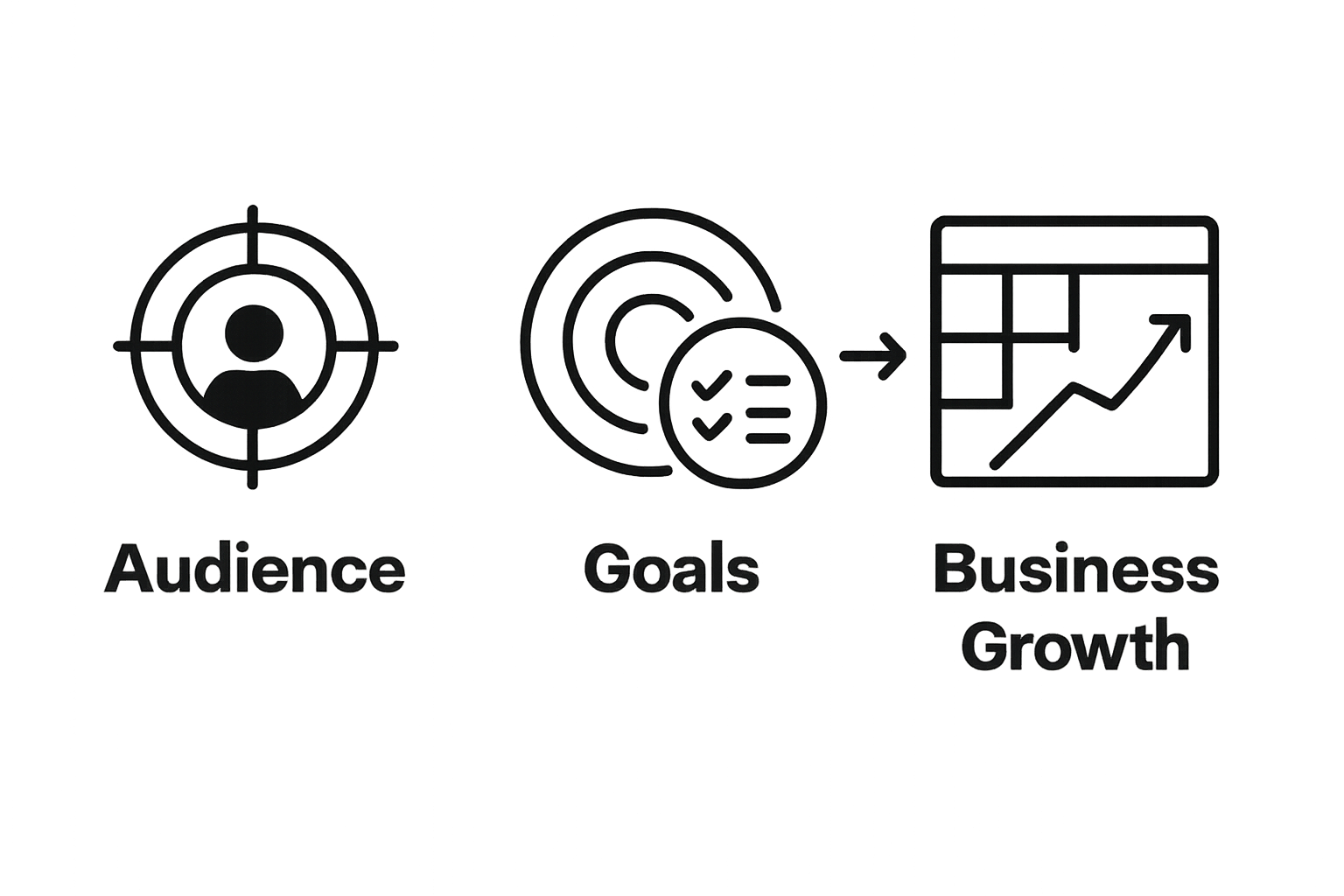Every business wants a marketing plan that actually works. Yet most small companies end up throwing money at social media or ads and hoping for the best. The real surprise? Small businesses that take time to define their audience and set clear goals are up to 4 times more likely to see strong marketing results. Forget trying to reach everyone. The smartest businesses focus on the right people and let the numbers guide their next move.
Table of Contents
- Step 1: Define Your Target Audience And Goals
- Step 2: Research Available Marketing Channels
- Step 3: Assess Budget And Resource Allocation
- Step 4: Select Channels That Align With Your Strategies
- Step 5: Test And Monitor Channel Performance
- Step 6: Adjust Your Strategy Based On Analytics
Quick Summary
| Key Point | Explanation |
|---|---|
| 1. Define your target audience carefully | Understand demographics and motivations to create detailed customer personas that guide your marketing efforts. |
| 2. Set SMART marketing goals | Goals should be specific, measurable, achievable, relevant, and time-bound to inform your overall strategy. |
| 3. Research marketing channels thoroughly | Evaluate various platforms and their fit for your target audience to optimize your marketing investments. |
| 4. Allocate budget wisely | Determine how much to spend on marketing and evenly distribute resources across effective channels based on ROI potential. |
| 5. Monitor and adjust strategies regularly | Use analytics and performance data to refine marketing tactics and maintain alignment with business objectives. |
Step 1: Define Your Target Audience and Goals
Successful marketing begins with crystal clear understanding of who you want to reach and what you aim to achieve. Defining your target audience and marketing goals is the critical foundation that will guide every subsequent marketing decision you make. This step transforms random marketing attempts into strategic, purposeful communication.
Starting your marketing journey requires deep insight into your potential customers. Demographic research becomes your roadmap. You need to understand not just basic characteristics like age and location, but the nuanced motivations, challenges, and desires of your ideal customer. For small businesses, this means creating a detailed customer persona that goes beyond surface level information. Imagine your perfect customer walking into your business their specific needs, pain points, and aspirations.
To effectively define your target audience, begin by examining your existing customer base. Look for common characteristics such as age ranges, professional backgrounds, income levels, and purchasing behaviors. Our guide on building a marketing strategy can provide additional insights into customer profiling. Consider conducting surveys or interviews with current customers to gather qualitative data that numbers alone cannot reveal.
Parallel to understanding your audience, you must crystallize your marketing goals. These goals should be specific, measurable, achievable, relevant, and time bound (SMART). Instead of vague objectives like “grow business,” articulate precise targets such as “increase online sales by 25% within six months” or “acquire 50 new customers through digital marketing channels by end of quarter.” These concrete goals will directly inform which marketing channels you ultimately select and how you measure their effectiveness.

Verify your audience definition and goals by asking these key questions:
- Does this target audience have a genuine need for my product or service?
- Can I clearly describe my ideal customer in detail?
- Are my marketing goals specific and quantifiable?
- Do my goals align with my overall business objectives?
Successful marketing is never about reaching everyone but about reaching the right people with the right message at the right time. By meticulously defining your target audience and goals, you create a strategic framework that transforms marketing from a scattershot approach to a precision instrument of business growth.
Below is a checklist table to help you verify your audience definition and goals, ensuring this foundational step is robust and actionable.
| Verification Step | Completion Criteria |
|---|---|
| Audience has a real need for product/service | Clearly identified needs align with your offering |
| Ideal customer is described in detail | Documented persona includes age, income, motivations, and challenges |
| Marketing goals are specific and quantifiable | Goals follow the SMART framework and outline precise numbers and deadlines |
| Goals align with overall business objectives | Each marketing goal directly supports broader business plans |
Step 2: Research Available Marketing Channels
Researching marketing channels transforms your strategy from guesswork into a precise, targeted approach. This critical step involves exploring and evaluating the diverse landscape of marketing platforms that can effectively connect your business with your ideal customers. Understanding the unique strengths and limitations of each channel will help you make informed decisions that maximize your marketing investment.
Digital marketing offers an expansive array of channels, each with distinct characteristics and potential reach. Social media platforms like Facebook, Instagram, and LinkedIn provide targeted advertising options that allow precise audience segmentation. Search engine marketing through Google Ads enables businesses to capture potential customers actively searching for related products or services. Email marketing remains a powerful direct communication method with impressive return on investment potential. Learn more about digital marketing strategies for beginners to understand these nuanced options.
Beyond digital platforms, traditional marketing channels still hold significant value for certain business types. Print advertising in local newspapers or industry magazines can effectively reach specific demographic groups. Radio and podcast advertising offer opportunities to connect with audiences during commutes or leisure time. Local community events and sponsorships provide direct engagement opportunities that digital channels cannot replicate.
When researching marketing channels, conduct a comprehensive evaluation that considers several critical factors. Assess the average customer acquisition cost for each channel, potential reach, engagement rates, and alignment with your target audience’s preferences. Analyze your competitors strategies to understand which channels are working effectively in your industry.
This table compares common marketing channels mentioned in the article, highlighting their key strengths, limitations, and typical use cases for South African small businesses.
| Channel | Strengths | Limitations | Best Use Cases |
|---|---|---|---|
| Facebook / Instagram | Targeted ads, high engagement, visual content friendly | Ad costs rising, requires relevant content | B2C, retail, local awareness |
| B2B networking, professional targeting | Smaller audience, can be costly | B2B services, professional recruitment | |
| Google Ads | Reaches intent-driven searches, measurable ROI | Can be competitive, needs ongoing tweaks | Lead generation, e-commerce, service search |
| Email Marketing | High ROI, direct communication | Requires good list, potentially ignored | Updates, promotions, relationship building |
| Print / Local Media | Good for older demographics, local reach | Difficult to track, limited targeting | Community engagement, special announcements |
| Radio / Podcast | Reaches commuters, local/regional audiences | Harder to track, production cost | Brand building, events, local awareness |
Consider your budget constraints and the potential return on investment for each marketing platform.
Verify your marketing channel research by checking these key indicators:
- Can you clearly articulate the strengths and weaknesses of each potential marketing channel?
- Have you estimated the potential reach and cost for each channel?
- Do the selected channels align closely with your target audience’s behaviors?
- Can you track and measure performance across these channels?
Successful marketing channel selection requires continuous learning and adaptability. The most effective strategy involves testing multiple channels, carefully measuring results, and remaining flexible enough to pivot when certain approaches are not delivering expected outcomes.
Step 3: Assess Budget and Resource Allocation
Budget and resource allocation represent the financial backbone of your marketing strategy, transforming theoretical plans into actionable initiatives. This step requires honest introspection about your financial capabilities and strategic deployment of limited resources. Marketing success is not about how much you spend, but how smartly you invest.
Begin by conducting a comprehensive audit of your current financial resources. Determine exactly how much capital you can realistically allocate to marketing without compromising other critical business operations. Explore smart digital marketing budget allocation strategies to understand sophisticated yet practical approaches. Small businesses typically recommend dedicating 7 to 12 percent of total revenue towards marketing efforts, though this percentage can fluctuate based on industry, growth stage, and competitive landscape.
Effective resource allocation goes beyond monetary investment. Consider the human capital required to execute your marketing strategy. Evaluate whether you have internal team members with the necessary skills or if you will need to hire external specialists, engage freelancers, or partner with digital marketing agencies. Some channels require specialized knowledge in areas like search engine optimization, social media management, or content creation. Assess your team’s current capabilities and identify potential skill gaps that might necessitate additional training or external support.
When distributing your marketing budget, adopt a strategic approach that balances immediate needs with long term growth potential. Allocate funds across different marketing channels proportionally, considering their proven effectiveness for your specific business model. Digital channels often provide more measurable and cost effective options compared to traditional advertising. Prioritize platforms that offer robust analytics, allowing you to track return on investment and make data driven adjustments.
Verify your budget and resource allocation by examining these critical checkpoints:
- Have you calculated a precise marketing budget based on realistic revenue projections?
- Can you clearly justify the investment in each selected marketing channel?
- Do you have mechanisms to track and measure the performance of your marketing spend?
- Have you built flexibility into your budget to pivot if certain strategies underperform?
Remember that budget allocation is not a one time event but an ongoing process of refinement. Successful marketing requires continuous monitoring, learning, and strategic realignment to maximize your investment and drive sustainable business growth.
Step 4: Select Channels That Align with Your Strategies
Selecting marketing channels is an art of precision matching your business objectives with the most effective communication platforms. This step transforms your research and planning into strategic action, ensuring that every marketing effort resonates with your target audience and drives meaningful business growth. The right channels act as strategic bridges connecting your brand with potential customers.
Consider the unique characteristics of each marketing channel through the lens of your specific business goals. Digital platforms offer remarkable targeting capabilities that traditional marketing cannot match. Social media channels like Facebook and Instagram excel at building brand awareness and engaging younger demographics, while LinkedIn provides exceptional B2B networking opportunities. Google Ads enables precise search intent targeting, allowing you to capture potential customers at the exact moment they are searching for solutions your business provides. Explore online advertising strategies for small businesses to understand nuanced channel selection techniques.
Your channel selection must transcend surface level demographics and dig deeper into audience behavior patterns. Analyze where your ideal customers consume information, interact online, and make purchasing decisions. A professional service might find more success with LinkedIn and targeted email marketing, while a visually oriented product could thrive on Instagram or Pinterest. The key is matching channel capabilities with your audience’s preferences and your brand’s communication style.
Multi channel strategies often yield the most robust results, allowing you to create a comprehensive marketing ecosystem. However, resist the temptation to spread your resources too thin. Start with 2 to 3 channels where you can consistently produce high quality, engaging content. Quality always trumps quantity in marketing communication. Focus on understanding each platform’s unique algorithms, content requirements, and audience engagement mechanisms.
Verify your marketing channel selection by examining these critical criteria:
- Do the selected channels directly reach your defined target audience?
- Can you consistently produce high quality content for these platforms?
- Are the channels measurable and aligned with your specific marketing goals?
- Do you have the resources to maintain an effective presence on these channels?
Remember that channel selection is not a permanent decision. The digital marketing landscape evolves rapidly, and successful marketers remain adaptable, continuously testing and refining their strategies to maintain optimal performance.
Step 5: Test and Monitor Channel Performance
Testing and monitoring marketing channel performance transforms guesswork into strategic insights, allowing businesses to optimize their marketing efforts with precision and confidence. This critical step turns data into actionable intelligence, revealing which strategies deliver results and which require refinement. Successful performance tracking is the difference between throwing marketing resources into the void and creating targeted, effective campaigns.
Implement a robust analytics framework from the outset of your marketing initiatives. Most digital platforms provide built in tracking tools that offer comprehensive performance metrics. Google Analytics, social media platform insights, and email marketing dashboards become your strategic command centers. These tools track critical indicators like engagement rates, click through rates, conversion percentages, and customer acquisition costs. Learn more about digital marketing performance tracking to understand the nuanced metrics that matter most.
Establish a consistent monitoring schedule that allows for meaningful data collection while providing opportunities for swift strategic adjustments. Weekly reviews of key performance indicators help you understand emerging trends, while monthly deep dive analyses provide comprehensive insights into channel effectiveness. Pay close attention to not just overall performance metrics, but the granular details that reveal audience behavior. Which content types generate the most engagement? What time of day do your audiences interact most actively? These micro insights can dramatically improve your marketing precision.
Develop a systematic approach to testing different marketing strategies through controlled experiments. A/B testing allows you to compare variations in messaging, visual design, posting times, and targeting parameters. By changing one variable at a time, you can scientifically determine which approaches resonate most effectively with your target audience. This methodical testing approach transforms marketing from an art into a data driven science, minimizing wasted resources and maximizing potential returns.
Verify your performance monitoring strategy by checking these essential criteria:
- Have you established clear, measurable performance benchmarks for each marketing channel?
- Can you track and compare performance across different platforms?
- Are you conducting regular performance reviews and strategic adjustments?
- Do you have a systematic approach to testing and improving marketing strategies?
Remember that performance monitoring is an ongoing process of learning and optimization. The most successful marketing strategies are those that remain flexible, data informed, and consistently responsive to changing audience behaviors and market dynamics.

Step 6: Adjust Your Strategy Based on Analytics
Analytics driven strategy adjustment represents the final and most dynamic phase of marketing channel optimization. Data transforms from passive information into an active strategic tool, enabling businesses to make intelligent, responsive decisions that continuously improve marketing performance. This step is about turning raw numbers into meaningful insights that drive tangible business growth.
Begin by establishing a comprehensive review process that goes beyond surface level metrics. Analyze not just the quantitative data like conversion rates and click throughs, but also the qualitative insights that reveal deeper audience behaviors. Explore advanced marketing analytics techniques for small businesses to understand the nuanced approach to data interpretation. Pay attention to engagement patterns, audience segmentation responses, and the subtle indicators that suggest shifting customer preferences.
Develop a systematic approach to strategy adjustment that balances data driven insights with strategic intuition. When analytics reveal underperforming channels, resist the impulse to eliminate them immediately. Instead, conduct granular analysis to understand why performance might be lagging. Are the messaging strategies misaligned? Is the targeting too broad or too narrow? Sometimes minor refinements can transform a seemingly ineffective channel into a powerful marketing asset. Implement incremental changes and closely monitor their impact, creating a continuous improvement cycle that keeps your marketing strategy agile and responsive.
Understand that strategic adjustment is not about chasing every data point, but about identifying meaningful patterns that align with your core business objectives. Create a framework that allows for both short term tactical adjustments and long term strategic pivots. This might involve reallocating budget between channels, refining audience targeting parameters, experimenting with different content formats, or exploring emerging marketing platforms that show promising initial performance.
Verify your strategy adjustment process by examining these critical checkpoints:
- Have you established a consistent schedule for comprehensive marketing performance reviews?
- Can you trace specific strategy changes back to actionable analytics insights?
- Are you maintaining a flexible approach that allows for rapid strategic iterations?
- Do your marketing adjustments consistently align with broader business goals?
Remember that successful marketing is an ongoing conversation with your audience. Analytics provide the language for this dialogue, helping you understand and respond to evolving customer needs with precision and creativity.
Ready to Turn Marketing Choices Into Real Business Growth?
Are you spending precious time trying to figure out which marketing channels truly deliver for your unique goals? The article highlighted how overwhelming it can feel to align platforms like Google Ads, Meta, and email with your limited budget and shifting customer needs. Many South African businesses struggle to track performance across channels and make data-based decisions that drive real results. If you want to move from scattered attempts to a powerful, data-driven marketing approach, now is the time to act.

Let Zoo Digital turn your insights into action. Our team can help you with everything from setting up expert Google Ads and configuring Meta and TikTok campaigns, to implementing robust tracking for accurate reporting. We specialise in solutions that suit your business size, your customer persona, and your growth targets. Visit Zoo Digital and book a consultation today. Take the stress out of channel selection and give your business the momentum it deserves.
Frequently Asked Questions
How do I define my target audience for marketing?
To define your target audience, conduct demographic research to understand their needs, preferences, and buying behaviors. Create detailed customer personas based on the characteristics of your existing customer base.
What criteria should I consider when selecting marketing channels?
You should assess each channel’s strengths and weaknesses, average customer acquisition costs, potential reach, engagement rates, and alignment with your target audience’s preferences. Consider which channels your audience uses most frequently.
How should I allocate my marketing budget?
Allocate your marketing budget based on realistic revenue projections, the effectiveness of each channel, and the skills available within your team. A common recommendation for small businesses is to dedicate 7 to 12 percent of total revenue to marketing efforts.
What should I do if my marketing channels are not performing well?
If marketing channels are underperforming, begin by analyzing performance data to identify issues. Make incremental changes and monitor their effects. It’s essential to remain flexible and willing to adjust your strategy based on the insights gained from your analytics.
Recommended
- How to Build a Marketing Strategy for Small Businesses in 2025 – Zoo Digital
- Digital Marketing for Beginners: 2025 Guide for Small Businesses – Zoo Digital
- Digital Marketing Budget Allocation: Smart Planning for 2025 – Zoo Digital
- How to Start Online Advertising: Guide for Small Businesses 2025 – Zoo Digital

